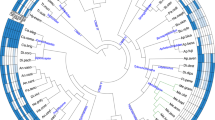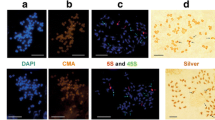Summary
There are sequences homologous to 5S ribosomal RNA in the ribosomal DNA (rDNA) repeats of the plant-parasitic nematodeMeloidogyne arenaria. This is surprising, because in all other higher eukaryotes studied to date, the genes for 5S RNA are unlinked to and distinct from a tandem rDNA repeat containing the genes for 18S, 5.8S, and 28S ribosomal RNA. Previously, only prokaryotes and certain “lower eukaryotes” (protozoa and fungi) had been found to have both the larger rRNAs and 5S rRNA represented within a single DNA repeat. This has raised questions on the organization of these repeats in the earliest cell (progenote), and on subsequent evolutionary relationships between pro- and eukaryotes.
Evidence is presented for rearrangements and deletions withinMeloidogyne rDNA. The unusual life cycles (different levels of ploidy, reproduction by meiotic and mitotic parthenogenesis) of members of this genus might allow rapid fixation of any variants with introduced 5S RNA sequences. The 5S RNA sequences inMeloidogyne rDNA may not be expressed, but their presence raises important questions as to the evolutionary origins and stability of repeat gene families.
Similar content being viewed by others
References
Arnheim N, Kuehn M (1979) The genetic behaviour of a cloned mouse ribosomal DNA segment mimics mouse ribosomal gene evolution. J Mol Biol 134:743–765
Back E, Muller F, Tobler H (1984) Structural organization of the two main rDNA size classes ofAscaris lumbricoides. Nucleic Acids Res 12:1313–1332
Clark CG (1987) On the evolution of ribosomal RNA. J Mol Evol 25:343–350
Curran J, McClure MA, Webster JM (1986) Genotypic differentiation ofMeloidogyne populations by detection of restriction fragment length difference in total DNA. J Nematol 18:83–86
Dover GA (1982) Molecular drive: a cohesive mode of species evolution. Nature 299:111–117
Drouin G, Hofman JD, Doolittle WF (1987) Unusual ribosomal RNA gene organization in copepods of the genusCalanus. J Mol Biol 196:943–946
Ellis RE, Sulston JE, Coulson AR (1986) The rDNA ofC. elegans: sequence and structure. Nucleic Acids Res 14:2345–2364
Erdmann VA, Wolters J (1986) Collection of published 5S, 5.8S and 4.5S rRNA sequences. Nucleic Acids Res 14:r1-r34
Files JG, Hirsh D (1981) Ribosomal DNA ofCaenorhabditis elegans. J Mol Biol 149:223–240
Frischauf A-M, Lehrach H, Poustka A, Murray N (1983) Lambda replacement vector carrying polylinker sequences. J Mol Biol 170:827–842
Gerbi S (1985) Evolution of ribosomal DNA. In: MacIntyre R (ed) Molecular evolutionary genetics. Plenum Press, New York, pp 419–517
Hattori M, Sakaki Y (1986) Dideoxysequencing method using denatured plasmid templates. Anal Biochem 152:232–238
Henikoff S (1984) Unidirectional digestion with exonuclease III creates targeted breakpoints for DNA sequencing. Gene 28:351–359
Honda BM, Nelson DW, Devlin RH, Khosla M (1986) Transcription of class III genes in cell-free extracts from the nematodeC. elegans. Nucleic Acids Res 14:869–881
Keil RL, Roeder GS (1984) Cis-acting, recombination-stimulating activity in a fragment of the ribosomal DNA ofS. cerevisiae. Cell 39:377–386
Maizels N (1976)Dictyostelium 17S, 25S and 5S rDNAs lie within a 38,000 base pair repeated unit. Cell 9:431–438
McMahon ME, Stamenkovich D, Petes TD (1984) Tandemly arranged variant 5S ribosomal RNA genes in the yeastS. cerevisiae. Nucleic Acids Res 12:8001–8016
Morgan GT, McMahon H (1986) Alterations in clonedXenopus ribosomal spacers generated by high-frequency plasmid recombination. Gene 49:389–394
Nazar RN, Wong WM (1985) Is the 5S RNA a primitive ribosomal RNA sequence? Proc Natl Acad Sci USA 82:5608–5611
Nelson DW, Honda BM (1985) Genes coding for 5S ribosomal RNA of the nematodeCaenorhabditis elegans. Gene 38:245–251
Pace NR, Olsen GJ, Woese CR (1986) Ribosomal RNA phylogeny and the primary lines of evolutionary descent. Cell 45:325–326
Platt T (1986) Transcription termination and the regulation of gene expression. Annu Rev Biochem 55:339–372
Rigby PWJ, Dieckmann M, Rhodes C, Berg P (1977) Labeling deoxyribonucleic acid to high specific activity in vitro by nick translation with DNA polymerase I. J Mol Biol 113:237–251
Sanger F, Nicklen S, coulson AR (1977) DNA sequencing with chain terminating inhibitors. Proc Natl Acad Sci USA 74:5463–5467
Selker EU, Yanofsky C, Driftmier K, Metzenberg RL, Alzner-DeWeerd B, RajBhandary UL (1981) Dispersed 5S RNA genes inN. crassa: structure, expression and evolution. Cell 24:815–818
Smith GE, Summers MD (1980) The bidirectional transfer of DNA and RNA to nitrocellulose or diazobenzyloxymethylpaper. Anal Biochem 10:123–129
Southern EM (1975) Detection of specific sequences among DNA fragments separated by gel electrophoresis. J Mol Biol 98:503–517
Triantaphyllou AC (1985) Cytogenetics cytotaxonomy and phylogeny of root-knot nematodes. In: Sasser JN, Carter CC (eds)Meloidogyne, vol 1. Biology and control. State University Graphics, Raleigh NC, pp 113–126
Vieira J, Messing J (1982) The pUC plasmids, and m13mp7-derived system for insertion mutagenesis and sequencing with synthetic universal primers. Gene 19:259–268
Wong WM, Abrahamson JLA, Nazar RN (1984) Are DNA spacers relics of gene amplification events? Proc Natl Acad Sci USA 81:1768–1770
Author information
Authors and Affiliations
Rights and permissions
About this article
Cite this article
Vahidi, H., Curran, J., Nelson, D.W. et al. Unusual sequences, homologous to 5S RNA, in ribosomal DNA repeats of the nematodeMeloidogyne arenaria . J Mol Evol 27, 222–227 (1988). https://doi.org/10.1007/BF02100078
Received:
Revised:
Issue Date:
DOI: https://doi.org/10.1007/BF02100078




